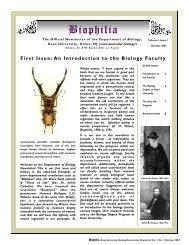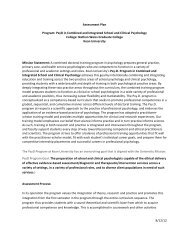Embodying the Sacred in Yoruba Art - Kean University
Embodying the Sacred in Yoruba Art - Kean University
Embodying the Sacred in Yoruba Art - Kean University
Create successful ePaper yourself
Turn your PDF publications into a flip-book with our unique Google optimized e-Paper software.
<strong>Embody<strong>in</strong>g</strong> <strong>the</strong> <strong>Sacred</strong> <strong>in</strong> <strong>Yoruba</strong> <strong>Art</strong><br />
By Babatunde Lawal<br />
The <strong>in</strong>terconnectedness of art and life <strong>in</strong> Africa is evident <strong>in</strong> many<br />
African cosmologies that not only trace <strong>the</strong> orig<strong>in</strong> of art to a High God or<br />
Supreme Div<strong>in</strong>ity or supernatural be<strong>in</strong>gs but also identify <strong>the</strong> human body<br />
as a piece of sculpture animated by a vital force or soul. Little wonder that<br />
<strong>the</strong> Ewe of Togo and Ghana, for <strong>in</strong>stance, call a human be<strong>in</strong>g amegbeto<br />
(liv<strong>in</strong>g molded clay). 1 In o<strong>the</strong>r words, an <strong>in</strong>dividual is alive as long as <strong>the</strong><br />
soul dwells <strong>in</strong> his or her body, and death results when <strong>the</strong> soul leaves that<br />
body. However, <strong>in</strong> many African cultures, death is not <strong>the</strong> end of life but<br />
ra<strong>the</strong>r a transition from physical to metaphysical existence, where, accord<strong>in</strong>g<br />
to popular belief, a dematerialized soul lives on and may re<strong>in</strong>carnate<br />
as a newborn baby. In effect, <strong>the</strong> body mediates and recycles life on earth;<br />
hence it is frequently stylized <strong>in</strong> African art to signify different phases of<br />
<strong>the</strong> existential process, to make <strong>the</strong> <strong>in</strong>tangible tangible, and to engender<br />
cherished social, spiritual, and aes<strong>the</strong>tic values. 2 This exhibition focuses<br />
on <strong>the</strong> manifestation of k<strong>in</strong>dred notions <strong>in</strong> examples of <strong>Yoruba</strong> art from <strong>the</strong><br />
Newark Museum.<br />
The <strong>Yoruba</strong><br />
The <strong>Yoruba</strong>, one of <strong>the</strong> largest ethnic groups <strong>in</strong> Africa, number more<br />
than twenty-five million people today and live ma<strong>in</strong>ly <strong>in</strong> Nigeria and<br />
<strong>the</strong> republics of Ben<strong>in</strong> and Togo (p. 10). They are made up of several<br />
k<strong>in</strong>gdoms, each headed by a k<strong>in</strong>g. Abundant natural resources enabled<br />
<strong>the</strong>m to develop one of <strong>the</strong> most complex cultures <strong>in</strong> sub-Saharan<br />
Africa. By <strong>the</strong> beg<strong>in</strong>n<strong>in</strong>g of <strong>the</strong> second millennium CE, Ilé-Ifè, <strong>the</strong>ir most<br />
sacred city, had become a major urban center with highly sophisticated<br />
religious, social, and political <strong>in</strong>stitutions. The ancient arts of Ilè-Ifè<br />
<strong>in</strong>clude extremely naturalistic terra-cotta and bronze sculptures dat<strong>in</strong>g<br />
from <strong>the</strong> eleventh to <strong>the</strong> sixteenth century, h<strong>in</strong>t<strong>in</strong>g at an era of economic<br />
prosperity and <strong>in</strong>tense cultural activity. 3 Although <strong>Yoruba</strong> culture appears<br />
to be homogeneous, <strong>the</strong>re are significant regional variations, which<br />
suggest that what we have today is a syn<strong>the</strong>sis of previously diverse,<br />
if related, elements. 4<br />
11

















